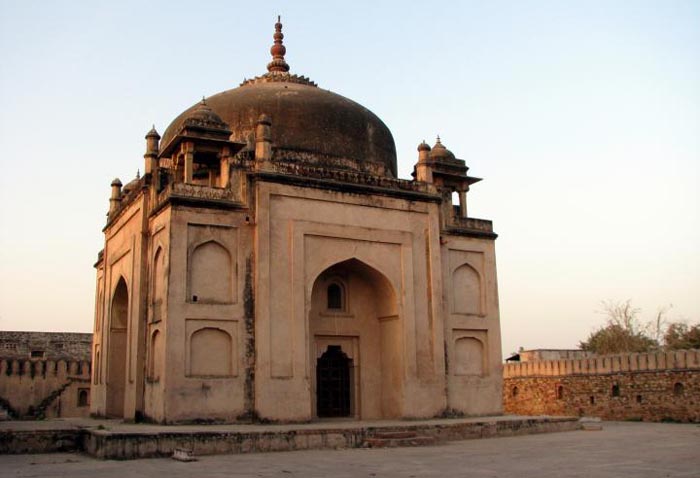Tomb of Itibar Khan

Information on Tomb of Itibar Khan (Agra, Uttar Pradesh) - History & Architecture
Tomb of Itibar Khan is a graceful building situated in the north western borders of Agra in Uttar Pradesh. The tomb is dedicated to Itibar Khan Khwajasara, who was a noble of king Bahadur Khan. Due to external twelve columns in the upper rotunda of the building, Tomb of Itibar Khan was also recognised as 'Barah Khamba'.
Tomb of Itibar Khan Architecture
Created in the year 1610, the tomb was once a massive compound with a mosque in the southern side along with a vast reservoir in the western side and series of wells in the eastern side. Nevertheless, railway pathway and two roadways have altered the place and the site was entirely changed. At present, only the mosque have survived. It is a small three-curved mosque surmounted by domes. The mosque possesses three domes, but only the dome of Itibar Khan is popular because, the other domes are known by Persian people only. There is a Persian caption, imprinted in relief of three columns above the arcs of the other domes.
The most interesting feature of the Tomb of Itibar Khan is the existence of twelve columns on the upper pavilion. It is surrounded by 'tibara-dalan' in the middle of eastern, western and northern portion of ground level with deep arches. Rubber and plaster are the key construction materials which were used in order to create the tomb. There is also a gallery in the monument along with a lovely horse idol which is created by red sandstone. In the southern side of the Tomb of Itibar Khan there is a small red sandstone entrance. The main entrance of the tomb directs to the central square funeral hall. The central hall of the Tomb of Itibar Khan comprises a rectangular shaped tomb of Itibar Khan.
Tomb of Itibar Khan History
Acted as a noble of king Bahadur Khan, Itibar Khan later served for King Akbar. He was also selected as an administrator of King Jahangir. Similar to his name, Itibar Khan was extremely loyal and thus, King Jahangir rested complete trust on him. He was the administrator of Agra in the year 1622 AD and was in charge of the protection of royal fort and assets. According to historical records, in the year 1623 AD, a rebel prince Shahjahan attempted to take control of the capital, Agra. On that time, Itibar Khan successfully defended the capital against Shahjahan's invasion. As a result, he was given the label of 'Mumtaz Khan' and 'Mansab of 6000 Zat and 500 Sawar'.
Itibar Khan died in the year 1623 AD and was buried in the tomb which was created erstwhile between 1610 AD to 1623 AD in the borders of Agra by Itibar Khan himself. It was stated that the mosque inside the monument was created by Khwajah Kafur who was a Sufi saint along with Itibar Khan. Additionally several living rooms were also created by them in the monument. The entire building of the Tomb of Itibar Khan was once a portion of a big compound namely 'Guru ka Tal' with a sarai, where the main tomb was centrally located.
Tomb of Itibar Khan Tourism Importance
Tomb of Itibar Khan is one of the historical attractions of Agra. Its striking red stonework along with the twelve columns is quite eye-catching for travellers to visit. Furthermore, there are various other structures and architectural designs inside the Tomb of Itibar Khan which makes it an important place from the viewpoint of tourism.
- Andaman Nicobar Monuments
- Andhra Pradesh Monuments
- Assam Monuments
- Bihar Monuments
- Chhattisgarh Monuments
- New Delhi Monuments
- Goa Monuments
- Gujarat Monuments
- Haryana Monuments
- Himachal Pradesh Monuments
- Jammu and Kashmir Monuments
- Karnataka Monuments
- Kerala Monuments
- Madhya Pradesh Monuments
- Maharashtra Monuments
- Odisha Monuments
- Punjab Monuments
- Rajasthan Monuments
- Tamil Nadu Monuments
- Telangana Monuments
- Uttar Pradesh Monuments
- West Bengal Monuments